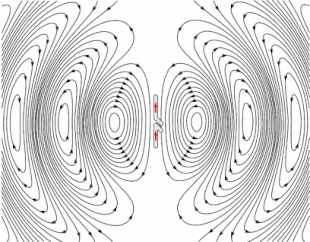A vertical rod, a usual dipole, produces radio waves in the horizontal plane, mostly in two opposite directions:
$\qquad \qquad \qquad \qquad \qquad $
If that is possible, how do you produce a spherical EM radiation? should the antenna be a (..n expanding and contracting) globe or a circle? How should the charges oscillate? and, lastly, would its energy decrease by 1/$4 \pi r^2$ and so its range would be rather short?
P.S. Someone said in a comment to
How is a spherical electromagnetic wave emitted from an antenna described in terms of photons?:
For some reason, my instinct is that a spherical electromagnetic wave
cannot be emitted by an antenna. Instead, they can only be emitted by
a charge. I guess that's cause I always think of an antenna as an
object that has no net charge. – Carl Brannen
Is this true? can you explain how a charge, say an electron, can produce a spherical wave? Also, does the section (the area) of a charge carry any info about its force or anything else?
Best Answer
A result known as Birkhoff's theorem forbids spherical electromagnetic radiation. The statement of the theorem is that any spherically symmetric vacuum solution to Maxwell's equations must be static. It is rather simple to prove. In a spherically symmetric solution $\mathbf E$ and $\mathbf B$ must be radial. Make an Ansatz, $$\mathbf E = E_0 \exp(i(\mathbf k\cdot\mathbf r-\omega t)) \hat r \quad \mathbf B = B_0 \exp(i(\mathbf k\cdot\mathbf r-\omega t)) \hat r $$ The wavevector $\mathbf k$ must be $\mathbf k = k\hat r$ for spherical symmetry. Now Ampere's law is $$\nabla\times \mathbf B = i\mathbf k \times \mathbf B = 0 = \partial_t \mathbf E = -i\omega \mathbf E$$ which implies $\omega = 0$, so that the field is static, or $E_0 = 0$. From Faraday's law $\nabla\times\mathbf E =- \partial_t \mathbf B$ you can see that if $E_0 = 0$ but $\omega \neq 0$, then also $B_0 = 0$.
The most general result for electromagnetic radiation is that in Coulomb gauge, in the radiation zone, the vector potential is $$\mathbf A(\mathbf x, t) = \frac{\mu_0}{4\pi }\frac{e^{i(kr-\omega t)}}{r} \int \mathbf J(\mathbf x') e^{-ik\hat{x} \cdot \mathbf x'} \, dx'$$ where $\mathbf J(\mathbf x')$ is the current in the source region, e.g., your antenna, and the current is assumed to have sinusoidal (harmonic) time dependence. [This is not a restriction because Maxwell's equations are linear and Fourier transform exists.]
The angular dependence is entirely in the integral over the source current. Thus to achieve some desired angular profile of the radiation, one needs to design $\mathbf J$ appropriately.
Your particular case of an oscillating sphere of charge actually does not radiate because it has only a monopole moment and there is no monopole radiation. A spheroidal charge distribution is treated by Jackson Classical Electrodynamics, Sec. 9.3. There Jackson shows that this arrangement leads to quadrupole radiation with a four-lobed distribution of radiated power. For a more in-depth discussion, read Ch. 9 in Jackson, which treats radiation in detail, including the angular distribution of radiated power from various sources.